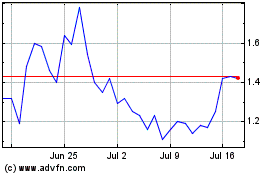Tron’s USDT Triumphs: Daily Volume Climbs Above $53 Billion, Dwarfing Visa
June 22 2024 - 4:00AM
NEWSBTC
USDT, Tether’s digital token pegged to traditional currencies, is
leading a quiet revolution in the world of finance. In a landmark
development, USDT has surpassed Visa’s average daily transaction
volume on the Tron blockchain, underscoring its position as the
undisputed leader in the stablecoin space. This surge signifies a
growing confidence in stablecoins and their potential to disrupt
the financial landscape. Related Reading: AI Crypto Fetch.ai (FET)
Makes ‘Big Bounce’ – Volume Spikes Over 200% Ahead Of Merger USDT
Flexes Muscles USDT’s dominance is evident. Available on multiple
blockchains, it has seen its market cap explode since its inception
in 2014. But the recent milestone on Tron, a blockchain known for
its lower transaction fees, is particularly noteworthy. Lookonchain
data reveals USDT transactions on Tron hitting a staggering $53
billion in a single day, exceeding Visa’s daily average of $42
billion. This 20% lead underscores the increasing adoption of
stablecoins for everyday transactions. The 24-hour trading volume
of $USDT on #TronNetwork is $53B, exceeding Visa’s average daily
trading volume. Visa’s trading volume in Q1 2024 was $3.78T and the
average daily trading volume was $42B. pic.twitter.com/jolGKIUcxE —
Lookonchain (@lookonchain) June 21, 2024 Why The Rise Of
Stablecoins? So, what’s driving this surge? Unlike traditional
cryptocurrencies known for their wild price swings, stablecoins
offer a haven of stability. They are typically pegged to fiat
currencies like the US dollar, meaning their value remains
relatively constant. This stability makes them ideal for everyday
transactions, eliminating the fear of sudden price drops that
plague traditional cryptocurrencies. Additionally, stablecoins
leverage the power of blockchain technology, enabling faster,
cheaper, and more transparent transactions compared to conventional
systems. Regulation On The Horizon As stablecoins gain traction,
governments are scrambling to establish regulatory frameworks. The
Lummis-Gillibrand Payment Stablecoin Act in the US and similar
initiatives in the UK highlight a global concern for ensuring user
protection and financial stability in the face of this innovation.
While these regulations are crucial for responsible growth,
navigating the ever-changing political climate adds another layer
of complexity. For instance, the UK’s crypto policy remains
uncertain with a looming general election. Related Reading: Follow
The Whales? Arthur Hayes Buys Pendle, Token Soars 25% The Future Of
Finance Despite the challenges, the momentum behind stablecoins
seems unstoppable. Their ability to bridge the gap between
traditional finance and the crypto world offers undeniable
advantages. While daily transaction volume can be volatile, and
concerns like rising transaction fees on Tron need to be addressed,
the overall trend is clear. Stablecoins are here to stay, and their
impact on the global financial system is likely to be profound. As
regulations take shape and the technology matures, stablecoins have
the potential to revolutionize the way we conduct everyday
transactions, ushering in a new era of financial inclusion and
efficiency. Featured image from Pexels, chart from TradingView
Fetch (COIN:FETUSD)
Historical Stock Chart
From May 2024 to Jun 2024

Fetch (COIN:FETUSD)
Historical Stock Chart
From Jun 2023 to Jun 2024
